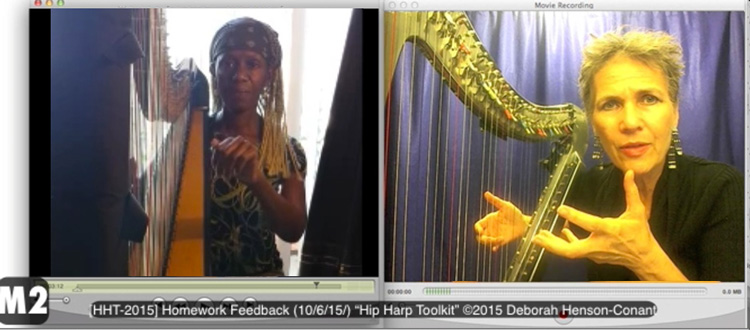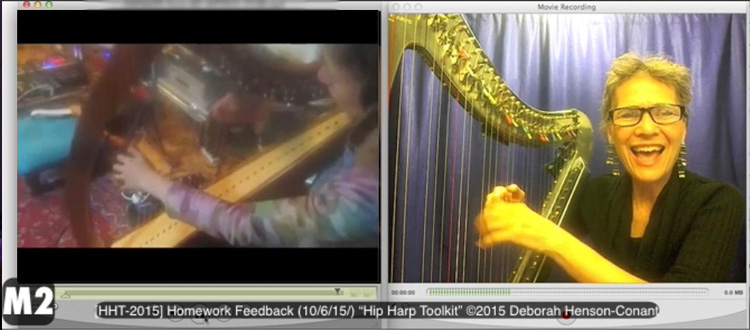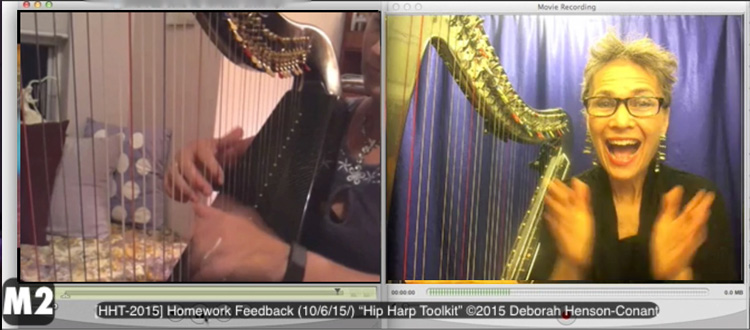I love coaching creative people – which is why I created an online school and mentor other creative artists – especially other harpists. On the other hand, I’ve never liked one-on-one teaching – which is why my online school is all my mentorship is a group mastermind and even when I offer lessons on tour, they’re always what I call “Mega-Lessons” – micro masterclasses with no fewer than 3 people.

Even when I used to work with my own mentor, Tony Montanaro, I always invited a buddy-artist so we could take notes and videotape for each other.
When I'm on the hot-seat being coached, everything is a blur to me so I need a buddy. Share on XWhen I’m on the hot-seat being coached, everything is a blur to me afterwards. So I need a buddy. And I often learn way more by watching other people being coached.
So when I created my online school, I wanted to create a way for that to happen: for students to give me real instances of their work and for me to give them real, spontaneous feedback on it, like I would in person – and for the whole group to benefit from my feedback.
This is what the feedback videos look like (below). Students present their homework as 90-second videos – then I pull up their video on my laptop, open my own live video window next to it and screencapture the whole thing so it seems as if we’re in the same room at the same time.

I give my students the same instructions I give myself: do it in one take, let it be imperfect – this is about learning, not about presenting or production. And I always request that they give me questions so I know what they particularly want coaching on.
My feedback video then gets posted inside the classroom and the feedback page becomes a big private virtual masterclass where each person in the class can benefit from my feedback to everyone in the course. The videos never leave the classroom, and only the students in the class have access to them.
And it WORKS! Students love this part of the courses – and they learn so much from it – not only from getting their own personalized feedback from me, but also what they learn from watching my feedback to others.

I didn’t make this idea up, by th
e way – I learned it from the
first online course I took from Mike King at Berklee Online. I realized I learned so much from Mike’s feedback to the other students that when I created my own online school, I vowed to figure out a way to do the same thing.
I learned so much from Mike's feedback to other students that I vowed to do the same Share on XThe trick was how to do it with video. Mike’s comments were all in text. But after a couple of years struggling to find a solution I finally figured it out – and I promise I’ll tell you below.

First I want to say that one of my biggest stumbling blocks was accepting that, to do this with any kind of spontaneity or fluency, I have to give up a certain level of technical finesse, and trust that the content is what’s valuable, not the production values.
In other words, I have to make the same creative leap my students do: go for fluency and spontaneity, and embrace it as connection and learning, not as a product that represents you.
Go for fluency and spontaneity. Embrace connection & learning. Share on XHere’s my workflow & technical basics:
- My amazing T.A. Margi downloads the student videos and I open them on my screen in Quicktime Player 7 (I have a souped-up older model MacBook Pro with 16GB of RAM, mag wheels and a furry set of dice – and I think Quicktime Player 7 is a pro version of Quicktime)
- In Quicktime, I open a “New Movie Recording” configured to capture my videocam and the feed from my “M-Audio Mobile Pre” (a USB pre-amp that mixes the signal from my voice and my electric harp)
- I use “Screenflow” to capture both those video streams, then export it to an .mp4 file and Margi uploads it back in the classroom.
Et voilà! Instant virtual masterclass!
On a side note – see those red glasses on my head? My microphone is taped to the glasses. They’re not just an awesome fashion statement, they’re my mic-stand. I use a Countryman mic. It’s probably overkill, but I grabbed it from an old wireless headset I had — and it works (unlike every other lapel mic I’ve tried to use), but only if I put it on top of my head.
Hey … whatever I have to do to make the connection!





Join for Freebies, Stories & News
Join to get weekly-ish emails with stories, videos & events like concerts & classes
Yay! You should get my next newsletter within the next 7-10 days. I'm so happy we'll be in touch!
I won't ever share your email address with others - and you can unsubscribe anytime, tho most people say they really enjoy these weeklish emails.